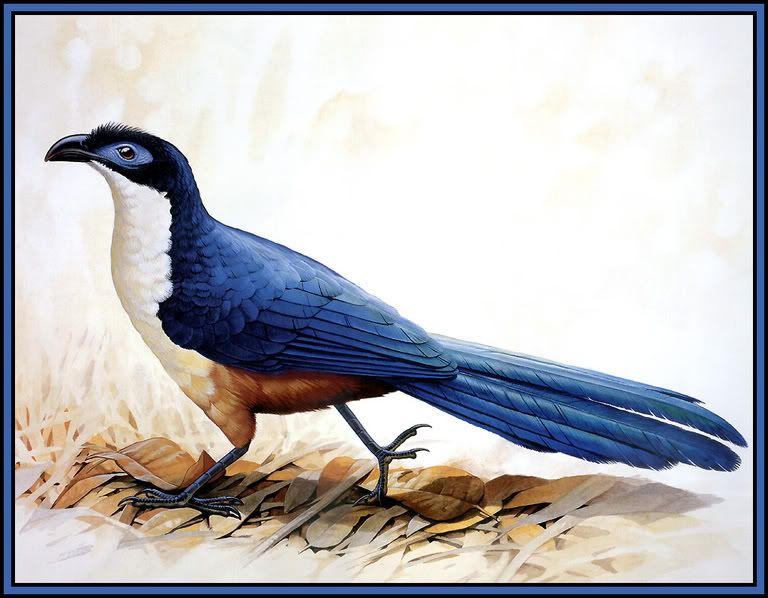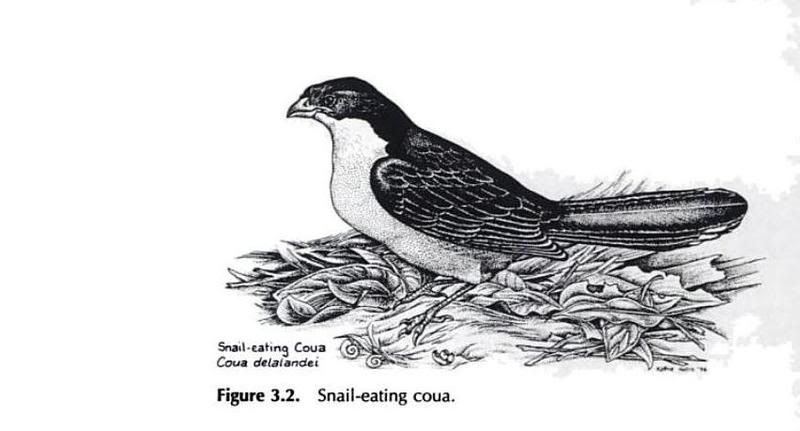|
|
Post by Melly on Mar 1, 2005 14:47:10 GMT
Snail-eating Coua Coua delalandei is known from 13 specimens, all apparently collected on Ile de Sainte-Marie (Nosy Boraha), Madagascar, with the most recent from 1834. Reports from 1930 are unfounded, and it is now considered extinct. It was a terrestrial species of primary rainforest, and therefore, the complete deforestation of Ile de Sainte-Marie was presumably the ultimate cause of its extinction. Snaring for feathers and food and predation by introduced rats may also have contributed to the species' demise.
|
|
Deleted
Deleted Member
Posts: 0
|
Post by Deleted on Mar 3, 2005 18:59:00 GMT
|
|
|
|
Post by sebbe67 on May 11, 2005 19:21:20 GMT
14 specimens are known if you should be exact  the last one collected 1834 on Nosy Boraha, there is no evidence that suggest that this bird ever have lived on the Madagascar "mainland". |
|
|
|
Post by another specialist on Nov 6, 2005 17:23:23 GMT
 Gap in nature |
|
|
|
Post by sebbe67 on Nov 26, 2005 0:05:22 GMT
Little can be said about Delalande's Coucal Coua delalandei( Temminck, 1827). This large, non-parasitic cuckoo, the only member of this family known to be extinct to date, was a ground dweller native to Madagascar. As for so many species of this island, the arrival of man proved fatal. The feathers were highly valued by the inhabitants, so hunting may have contributed to its extinction. When European settlers arrived, more threats were introduced: rats, cats and other predators were released and the habitat of the bird was destroyed. All museum specimens of Delalande's Coucal were collected in a relatively short period of time. C.J. Temminck, the founder and first director of the National Museum of Natural History, described the species in 1827 on the basis of 'a unique specimen' which he had seen in the Muséum d'Histoire naturelle in Paris. The last Delalande's Coucal to be collected, was sent to that same museum only seven years later by Chevalier J.A. Bernier. He had also shot the specimen from the National Museum of Natural History. Although the species has not been collected since 1834, it appears to have survived much longer. The last sightings date from the 1920's. Apart from Leiden en Paris, specimens are preserved in the museums of Tring, New York, Philadelphia, Cambridge ( U.S.A.) and Tananarive ( Madagascar). www.naturalis.nl/300pearls/photos on museum specimens www.foek.hu/dodo/madar/code.htmpicture Snail-eating Coua Coua delalandei, which was last recorded in 1834. Investigations and interviews with local people on the adjacent mainland have failed to indicate that the species ever occurred elsewhere, and it is assumed that deforestation on the island was the principal cause of the species' demise, with hunting and predation by introduced rats Rattus rattus also contributing www.birdlife.org/datazone/ebas/?action=EbaHTMDetails.asp&sid=349&m=0 |
|
|
|
Post by another specialist on Nov 26, 2005 22:59:00 GMT
|
|
|
|
Post by sebbe67 on Jan 21, 2006 11:37:15 GMT
the large Snail-eating Coua (Coua delalandei), a member of the cuckoo family, became extinct. The last specimen of this large, slate-blue bird was taken on an islet off the east coast, Ile Sainte-Marie, in 1834 (Morris and Hawkins 1998); reports by observers who claimed to have seen the bird were recorded as late as 1930 (Fuller 1987). The causes of this bird's disappearance, and even its exact range, remain obscure (Langrand 1990). Many specimens of this bird were taken before its extinction and kept in museums in Leiden; London; New York; Paris; Philadelphia; Tananarive (Madagascar); and Cambridge (Massachusetts) (Fuller 1987). The long feathers of this bird were highly valued by the Malagasy, and hunting may have reduced its numbers to a critically low level (Fuller 1987). It is also possible that the many birds killed for zoological specimens may have pushed this already rare bird to extinction, since its distribution may have been limited to the tiny Ile Sainte-Marie. No reliable record exists of its presence on the main island of Madagascar, but there is hope that it might be found in lowland forest near the Bay of Antongil (Morris and Hawkins 1998). Ten closely related species of couas survive, all smaller than the Snail-eating Coua. www.endangeredspecieshandbook.org/madagascar_human.php |
|
|
|
Post by another specialist on Jan 31, 2006 19:40:30 GMT
|
|
|
|
Post by another specialist on Jan 31, 2006 19:42:58 GMT
|
|
|
|
Post by Carlos on Feb 28, 2006 18:37:46 GMT
Text in Langrand (1991:214)*
"Endemic to Madagascar, considered extinct. Known by 13 specimens kept in museums throughout the world. The only labels specifying collection site read 'Ile Sante-Marie'. The hypothesis that species frequents forests on Pointe-à-Larrée, across from Ile Sainte-Marie, and the expanse of forest between Fito and Maroantsetra, has no factual basis. Deforestation would be the principal cause of this local species's demise, but hunting and the introduction of rats (Rattus rattus) would have also contributed to its extinction."
* Langrand, O. (1991): Guide to the birds of Madagascar. Yale University Press. New Haven & London. 364 pp.
|
|
|
|
Post by another specialist on Sept 12, 2008 6:18:50 GMT
|
|
|
|
Post by another specialist on Nov 20, 2008 10:04:17 GMT
 Conservation Biology in Theory and Practice By Graeme Caughley, Anne Gunn |
|
|
|
Post by koeiyabe on Dec 4, 2015 19:56:15 GMT
"Lost Animals (in Japanese)" by WWF Japan (1996)  |
|
|
|
Post by argentavis on Sept 17, 2016 16:57:20 GMT
|
|
|
|
Post by surroundx on Sept 18, 2016 13:22:39 GMT
|
|
|
|
Post by Sebbe on Sept 3, 2024 17:09:27 GMT
|
|